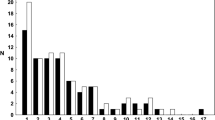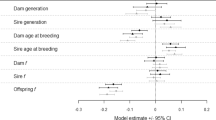Abstract
We present a new idea about the possible effects of human-induced mortality on different age cohorts (i.e., breeders vs. juveniles) in long-lived animals. Our hypothesis is based on Curio’s idea on the effect of natural selective processes on cohorts to explain age-related increases in fecundity (selection hypothesis). We believe that negative human pressure may modify such contribution to reproduction of good versus low quality phenotypes, altering the genetic structure of the population. Ecologists and environmental managers in general should be aware of how stochastic events provoked by humans may induce changes in the genetic structure of populations.
Similar content being viewed by others
References
Amos B. 1996. Levels of genetic variability in cetacean populations have probably changed little as a result of human activities. Report International Whaling Commission 46: 657–658.
Arroyo B., Ferreiro E. and Garza V. 1998. Causas de la regresión del Águila Perdicera Hieraaetus fasciatus en España Central. In: Chancellor R.D., Meyburg B.-U. and Ferrero J.J. (eds) Holarctic Birds of Prey. ADENEX-WWGBP, Merida, Spain, pp. 291–304.
Balbontín J., Penteriani V. and Ferrer M. 2000. El águila perdicera en Andalucía: situación actual y tendencias en las áreas de reproducción y de dispersión juvenil. CSIC/Junta de Andalucía, Sevilla, Spain.
Balbontín J., Penteriani V. and Ferrer M. 2003. Variations in the age of mates as an early warning signal of changes in population trends? The case of Bonelli’s eagle in Andalusia. Biological Conservation 109: 417–423.
Baranyi C., Gollman G. and Bobin M. 1997. Genetic and morphological variability in roach (Rutilus rutilus), from Austria. Hydrobiologia 350: 13–23.
Becher S.A. and Griffiths R. 1998. Genetic differentiation among local populations of the European hedgehog (Erinaceus europaeus) in mosaic habitats. Molecular Ecology 7: 1599–1604.
Bezzel E. and Fünfstück H.-J. 1994. Brutbiologie und Populationsdynamik des Steinadlers Aquila chrysaetos im Werdenfelser Land/Oberbayern. Acta Ornithoecologica 3: 5–32.
Bowman T.D., Schempf P.F. and Bernatowicz J.A. 1995. Bald Eagle survival and population dynamics in Alaska after Exxon Valdez oil spill. Journal of Wildlife Management 59: 317–324.
Brook B.W., O’Grady J.J., Chapman A.P., Burgman M.A., Akçakaya H.R. and Frankham R. 2000. Predictive accuracy of population viability analysis in conservation biology. Nature 404: 385–387.
Brown L.H. and Pommery D.E. 1984. The age structure of populations of wild birds in tropical Africa as demonstrated by plumage characters and marking techniques. In: Proceedings of the V Pan-African Ornithological Congress, pp. 97–119.
Cam E. and Monnat J.-Y. 2000. Apparent inferiority of first-time breeders in the kittiwake: the role of heterogeneity among age classes. Journal of Animal Ecology 69: 380–394.
Charlesworth B. 1994. Evolution in Age-structure Populations. 2nd edn. Cambridge University Press, Cambridge, UK.
Curio E. 1983. Why do young birds reproduce less well? Ibis 125: 400–404.
Desrochers A. and Magrath R.D. 1993. Age-specific fecundity in European Blackbirds (Turdus merula): individual and population trends. Auk 110: 255–263.
Donázar J.A., Palacios C.J., Gangoso L., Ceballos O., González M.J. and Hiraldo F. 2002. Conservation status and limiting factors in the endangered population of Egyptian vulture (Neophron percnopterus) in the Canary Islands. Biological Conservation 107: 89–97.
Enderson J.H. 1969. Peregrine and Prairie falcon life tables based on band-recovery data. In: Hickey J.J. (ed) Peregrine Falcon Populations: Their Biology and Decline. University of Wisconsin Press, Madison, Wisconsin, pp. 505–508.
Espie R.H.M., Oliphant L.W., James P.C., Warkentin I.G. and Lieske D.J. 2000. Age-dependent breeding performance in Merlins (Falco columbarius). Ecology 81: 3404–3415.
Ferrer M. and Calderón J. 1990. The Spanish Imperial Eagle (Aquila adalberti) in Doñana National Park: a study of population dynamics. Biological Conservation 51: 151–161.
Forero G.M. 1998. Dispersión o filopatria? Análisis de sus causas y consecuencias en la población de milanos negros de Doñana. Ph.D. Dissertation, University of Seville, Spain.
Forslund P. and Pärt T. 1995. Age and reproduction in birds - hypotheses and tests. Trends in Ecology and Evolution 10: 374–378.
Gargett V. 1990. The Black Eagle. Acorn Books, Randburg, South Africa.
Gerrad J.M., Gerrad P.N., Bortolotti G.R. and Dzus E.H. 1992. A 24-year study of Bald Eagles on Besnard Lake, Saskatchewan. Journal of Raptor Research 26: 159–166.
Gibbs J. 1998. Genetic structure of redback salamander Plethodon cinereous populations in continuous and fragmented forests. Biological Conservation 86: 77–81.
Hamilton W.D. 1966. The molding of senescense by natural selection. Journal of Theoretical Biology 12: 12–45.
Haukioja E. and Haukioja M. 1970. Mortality rates of Finnish and Swedish Goshawks (Accipiter gentilis). Finnish Game Research 31: 13–20.
Henny C.J. 1969. Geographical variation in mortality rates and production requirements of the barn owl (Tyto alba). Bird-Banding 40: 277–356.
Henny C.J. 1972. An analysis of the population dynamics of selected avian species. Research Report 1. Bureau Sport Fisheries and Wildlife, Washington, DC.
Henny C.J. and Wight H.M. 1969. An endangered Osprey population: estimates of mortality and production. Auk 86: 188–198.
Henny C.J. and Wight H.M. 1972. Red-tailed and Cooper’s Hawks: their population ecology and environmental pollution. In: Population Ecology of Migratory Birds. Symposium Volume, Patuxent Wildlife Research Center, Laurel, Maryland, pp. 229–250.
Hickey J.J. 1952. Survival studies of banded birds. US Dept. Int. Spec. Sci. Rep. Wildlife 15.
Hiraldo F., Negro J.J., Donázar J.A. and Gaona P. 1996. A demographic model for a population of the endangered lesser kestrel in southern Spain. Journal of Applied Ecology 33: 1085–1093.
Höglund N. 1964. Der Habicht Accipiter gentilis Linné in Fennoscandia. Viltrevy 2: 195–270.
James P.C., Warkentin I.G. and Oliphant L.W. 1989. Turnover and dispersal in urban merlins Falco columbarius. Ibis 131: 426–447.
Jenkins J.M. 1996. Modelling of a resident Bald Eagle Haliaeetus leucocephalus population using empirical life table parameters. In: Meyburg B.-U. and Chancellor R.D. (eds) Eagles Studies. WWGBP, Berlin, Germany, pp. 189–198.
Kramer K. 1973. Habicht und Sperber. Die Neue Brehm-Bücherei. Ziemsen Verlag, Wittenberg Lutherstadt, Germany.
Krane D.E., Sternberg D.C. and Burton G.A. 1999. Randomly amplified polymorphic DNA profile-based measures of genetic diversity in crayfish correlated with environmental impacts. Environmental Toxicology and Chemistry 18: 504–508.
Lindberg P. 1977. The Peregrine Falcon in Sweden. In: Proceedings of the ICBP World Conference on Birds of Prey, Vienna, Austria, pp. 329–338.
Mebs T. 1964. Zur Biologie und Populationsdynamik des Mäusebussards Buteo buteo. Journal für Ornithologie 105: 247–306.
Mebs T. 1971. Death causes and mortality rates of Peregrines Falco peregrinus calculated by German and Finnish band-recoveries. Die Vogelwarte 26: 98–105.
Meffe G.K. and Carrol C.R. (eds) 1994. Principles of Conservation Biology. Sinauer Associates, Sunderland, Massachusetts.
Moulton M.P. and Sanderson J. 1999. Wildlife Issues in a Changing World. CRC Press, Boca Raton, Florida.
Newton I. 1975. Movements and mortality of British Sparrowhawks. Bird Study 22: 35–43.
Newton I. 1981. Age and breeding in Sparrowhawks. Journal of Animal Ecology 50: 839–853.
Newton I. 1986. The Sparrowhawk. T and AD Poyser, Calton, UK.
Newton I. (ed) 1989. Lifetime Reproduction in Birds. Academic Press, London.
Nielsen J.T. and Drachmann J. 2003. Age-dependent reproductive performance in Northern Goshawks Accipiter gentilis. Ibis 145: 1–8.
Nordstrom G. 1963. Einige Ergebnisse der Vogelberingung in Finnland in der Jahren 1913–1962. Ornis Fennica 40: 81–124.
Olsen P.D. and Olsen J. 1988. Population trends, distribution, and status of the Peregrine Falcon in Australia. In: Cade T.J., Enderson J.H., Thelander C.J. and White C.M. (eds) Peregrine Falcon Populations. The Peregrine Fund, Inc., Boise, Idaho, pp. 255–287.
Olsson O. 1958. Dispersal, migration, longevity and death causes of Strix aluco, Buteo buteo, Ardea cinerea and Larus argentatus. Acta Vertebratica 1: 91–189.
Partridge L. 1989. Lifetime reproductive success and life-history evolution. In: Newton, I. (ed). Lifetime Reproduction in Birds. Academic Press, London, pp. 421–440.
PBRG (Predatory Bird Research Group) 1995. A pilot Golden Eagle population study in the Altamont Pass Wind Resource Area, California. University of California, Santa Cruz, California.
Penteriani V., Balbontín J. and Ferrer M. 2003. Simultaneous effects of age and territory quality on fecundity in Bonelli’s Eagle (Hieraaetus fasciatus). Ibis 145: E77-E82.
Piper S.E., Mundy P.J. and Ledger J.A. 1981. Estimates of survival in the Cape Vulture Gyps coprotheres. Journal of Animal Ecology 50: 815–825.
Postupalski S. 1989. Osprey. In: Newton I. (ed) Lifetime Reproduction in Birds. Academic Press, London, pp. 297–313.
Primack R.B. 1994. Essentials of Conservation Biology. Sinauer Associates, Sunderland, Massachusetts.
Real J., Mañosa S. and Codina J. 1996a. Estatus, demografía y conservación del Aguila perdicera Hieraaetus fasciatus en el Mediterráneo. In: Muntaner J. and Mayol J. (eds) Biología y Conservación de las Rapaces Mediterráneas. Monografía No. 4, SEO, Madrid, Spain, pp. 83–89.
Real J., Mañosa S., Cheylan G., Bayle P., Cugnasse J.M. and Sánchez-Zapata J.A. 1996b. A preliminary demographic approach to the Bonelli’s Eagle Hieraaetus fasciatus population decline in Spain and France. In: Meyburg B.-U. and Chancellor R.D. (eds) Eagles Studies. WWGBP, Berlin, Germany, pp. 523–528.
Real J., Grande J.M., Mañosa S. and Sánchez-Zapata J.A. 2001. Geographic variation of the causes of death of Bonelli’s Eagle (Hieraaetus fasciatus) in Spain. Bird Study 48: 221–228.
Reisenbichler R.R. 1997. Genetic factors contributing to declines of anadromous salmonids in the Pacific Northwest. In: Naiman R.J. (ed) Pacific Salmon and Their Ecosystems: Status and Future Options. Chapman & Hall, New York, pp. 223–244.
Roest A.I. 1957. Notes on the American Sparrowhawk. Auk 74: 1–19.
Ruckelshaus M.H., Levin P., Johnson J.B. and Kareiva P.M. 2002. The Pacific Salmon Wars: what science brings to the challenge of recovering species. Annual Review of Ecology and Systematics 33: 665–706.
Sæther B.E. 1983. Age-specific variation in reproductive performance of birds. In: Power D.M. (ed) Current Ornithology, Vol. 7. Plenum Press, New York, pp. 251–283.
Sæther B.-E., Ringsby T.H. and Roskaft E. 1996. Life history variation, population processes and priorities in species conservation: towards a reunion of research paradigms. Oikos 77: 217–226.
Saurola P. 1976. Mortality of Finnish Goshawks. Suomen Luonto 6: 310–314.
Saurola P. 1983. Population dynamics of the Osprey in Finland during 1971–1980. In: Bird D.M. (ed.) Biology and Management of Bald Eagles and Ospreys. Harpell Press, Ste. Anne de Bellevue, Quebec, Canada, pp. 201–206.
Schelde O. 1960. The migration of Danish Sparrowhawks (Accipiter nisus) L. Dansk Orn. For. Tidssk 54: 88–102.
Schifferli A. 1964. Lebensdauer, Sterblichkeit und Todesursachen beim Turmfalken, Falco tinnunculus. Ornithologische Beobachter 61: 81–89.
Schifferli A. 1967. Vom Zug Schweizerischer und Deutscher Schwarzer Milane nach Ringfunden. Ornithologische Beobachter 64: 34–51.
Sherrod S.K., White C.M. and Williamson F.S.L. 1977. Biology of the Bald Eagle on Amchitka Island, Alaska. Living Bird 15: 143–182.
Snow D.W. 1968. Movements and mortality of British Kestrels Falco tinnunculus. Bird Study 15: 65–83.
Steenhof K., Kochert M.N. and Doremus J.H. 1983. Nesting of subadult Golden Eagles in southwestern Idaho. Auk 100: 743–747.
Taylor I. 1994. Barn Owls. Predator-Prey Relationships and Conservation. Cambridge University Press, Cambridge, UK.
Thirgood S., Redpath S., Newton I. and Hudson P. 2000. Raptors and Red grouse: conservation conflicts and management solutions. Conservation Biology 14: 95–104.
Thraikill J.A., Anthony R.G. and Meslow E.C. 1997. An update of demographic estimates for northern spotted owls Strix occidentalis caurina from Oregon-s Central Coast Ranges. In: Duncan J.R., Johnson D.H. and Nicholls T.H. (eds) Biology and Conservacion of Owls of the Northern Hemisphere. USDA Forest Service, General Technical Report NC-190, St. Paul, Minnesota.
Tinbergen L. 1946. Sperver als Roofvijand van Zangvogels. Ardea 34: 1–123.
Vaupel J.W. and Yashin A.I. 1985. Heterogeneity’s ruses: some surprising effects of selection on population dynamics. American Statistician 39: 176–185.
Village A. 1990. The Kestrel. T and AD Poyser, London.
Wachter K.W. and Finch C.E. 1997. Between Zeus and the Salmon. The Biodemography of Longevity. National Academy Press, Washington, DC.
Watson D. 1977. The Hen Harrier. T and AD Poyser, Berkhamsted, UK.
Watson J. 1997. The Golden Eagle. T and AD Poyser, London.
Weimerskirch H. and Jouventin P. 1987. Population dynamics of the wandering albatross, Diomedea exulans, of the Crozet Island: causes and consequences of the population decline. Oikos 49: 315–322.
Wilson E.O. (ed) 1988. Biodiversity. National Academy Press, Washington, DC.
Author information
Authors and Affiliations
Corresponding author
Rights and permissions
About this article
Cite this article
Balbontín, J., Penteriani, V. & Ferrer, M. Humans act against the natural process of breeder selection: A modern sickness for animal populations?. Biodivers Conserv 14, 179–186 (2005). https://doi.org/10.1007/s10531-005-5043-3
Received:
Accepted:
Issue Date:
DOI: https://doi.org/10.1007/s10531-005-5043-3




